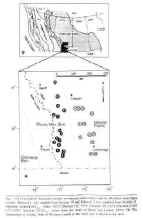Geoderma, 87(1999), 209-237
PEDOGENIC AND DIAGENETIC INFLUENCES ON VOID COATING FORMATION IN LOWER
CRETACEOUS PALEOSOLS OF THE
MILL CREEK FORMATION, SOUTHWESTERN ALBERTA, CANADA
PAUL J. MCCARTHY1, I. PETER MARTINI1 and DALE A. LECKIE2
1Department of Land Resource Science, University of Guelph, Guelph,
Ontario, Canada NlG 2Wl
2Institute of Sedimentary and Petroleum Geology, Geological Survey of
Canada, 3303-33rd St., N. W., Calgary, Alberta, Canada T2W 2A7
¡¡
 Pedogenic and diagenetic influences on void coating formation were studied in
two paleosols from the Lower Cretaceous (Albian) Mill Creek Formation in
southwestern Alberta, Canada, using detailed micromorphological, mineralogical
and geochemical methods. The paleosols consist of alternating decirnetre-scale
beds of red, grey-green and variegated mudstone. Intermediate horizons (red and
grey-green variegated mudstones) contain associations of pale yellow clay
coatings, dark red clay coatings, Fe-depletion hypo-coatings and Fe-oxide
quasi-coatings. SEM-EDX-ray analyses indicate that the dark reddish coatings are
dominated by Si, Al and Fe, with subordinate amounts of K, Na, Ca, Mg and Ti.
Pale yellow clay coatings have a higher Si content, and lower Al, K, Na, Ca and
Fe contents relative to reddish coatings. Within the paleosol profiles, the
distribution of clay minerals indicates: (I) an increase in discrete clay
minerals downward, (2) a decrease in mixed layer illite-smectite downward and
(3) an increase in chlorite upward. X-ray diffraction indicates that the pale
yellow and dark red clay void coatings are polymineralic. Pale yellow clay
coatings have a higher proportion of mixed layer illite-smectite and kaolinite,
less chlorite and are less crystalline than dark reddish coatings. Despite a
diagenetic overprint, including development of diffusion gleyans, degradation of
organic matter, burial reddening, and probably some smectite illitization, both
compositional and morphological gradients exist in the paleosol profiles and
void coatings. These gradients are most likely related to depositional
variations and to pedogenic development in the original soils under variable
Eh-pH conditions in the presence of organic matter. Therefore, although the void
coatings are altered (diagenetic features) their morphology, mineralogy and
perhaps even some of their microchemistry is attributable to the presence of
pedogenic precursors initially formed in soils similar to modern, temperate
Alfisols and glossic soils.
Pedogenic and diagenetic influences on void coating formation were studied in
two paleosols from the Lower Cretaceous (Albian) Mill Creek Formation in
southwestern Alberta, Canada, using detailed micromorphological, mineralogical
and geochemical methods. The paleosols consist of alternating decirnetre-scale
beds of red, grey-green and variegated mudstone. Intermediate horizons (red and
grey-green variegated mudstones) contain associations of pale yellow clay
coatings, dark red clay coatings, Fe-depletion hypo-coatings and Fe-oxide
quasi-coatings. SEM-EDX-ray analyses indicate that the dark reddish coatings are
dominated by Si, Al and Fe, with subordinate amounts of K, Na, Ca, Mg and Ti.
Pale yellow clay coatings have a higher Si content, and lower Al, K, Na, Ca and
Fe contents relative to reddish coatings. Within the paleosol profiles, the
distribution of clay minerals indicates: (I) an increase in discrete clay
minerals downward, (2) a decrease in mixed layer illite-smectite downward and
(3) an increase in chlorite upward. X-ray diffraction indicates that the pale
yellow and dark red clay void coatings are polymineralic. Pale yellow clay
coatings have a higher proportion of mixed layer illite-smectite and kaolinite,
less chlorite and are less crystalline than dark reddish coatings. Despite a
diagenetic overprint, including development of diffusion gleyans, degradation of
organic matter, burial reddening, and probably some smectite illitization, both
compositional and morphological gradients exist in the paleosol profiles and
void coatings. These gradients are most likely related to depositional
variations and to pedogenic development in the original soils under variable
Eh-pH conditions in the presence of organic matter. Therefore, although the void
coatings are altered (diagenetic features) their morphology, mineralogy and
perhaps even some of their microchemistry is attributable to the presence of
pedogenic precursors initially formed in soils similar to modern, temperate
Alfisols and glossic soils.